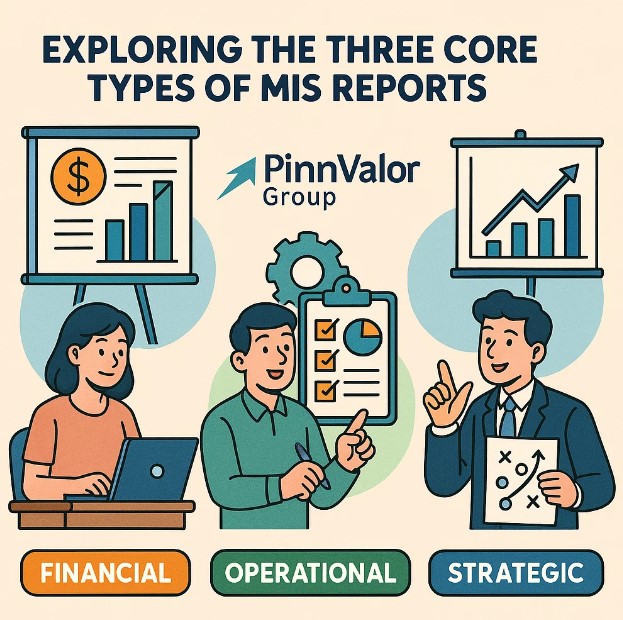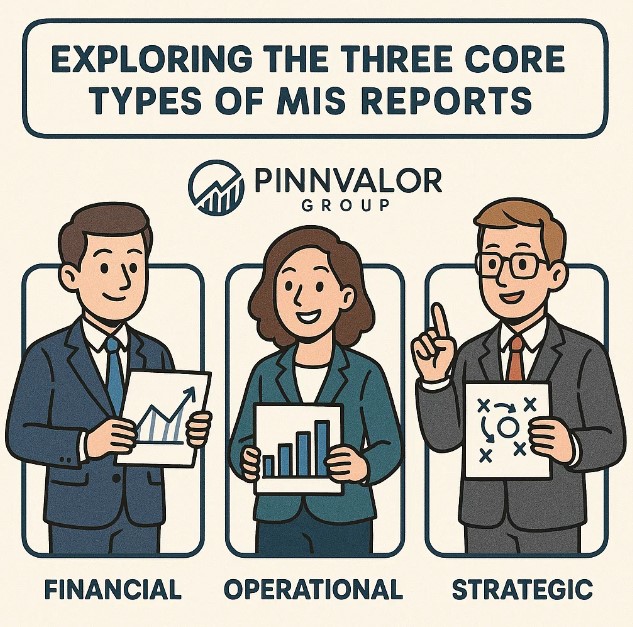
Exploring the Three Core Types of MIS Reports: Financial, Operational, and Strategic
In today’s data-driven business landscape, Management Information Systems (MIS) play a vital role in helping organizations make informed decisions, improve efficiency, and maintain a competitive edge. One of the key functions of MIS is to generate reports that support various levels of management. These reports provide critical insights into business performance and guide strategic, operational, and financial decisions.
Which MIS report type holds the insights you need to drive your business forward?
MIS reports provide critical insights that empower businesses to optimize operations and make informed strategic decisions.
In this blog, we’ll explore the three core types of MIS reports—Financial, Operational, and Strategic—highlighting their unique features, purposes, and examples.
1. Financial MIS Reports: Driving Fiscal Discipline and Transparency
Purpose:Financial MIS reports focus on the economic health of an organization. These reports help track income, expenses, profitability, and other key financial indicators. They are primarily used by top management, finance teams, investors, and regulatory authorities to assess financial performance and ensure compliance.
Key Features:- Historical and real-time financial data
- Budget vs. actual analysis
- Forecasting and trend analysis
- Compliance with accounting standards and regulations
- Income Statement (Profit & Loss Report): Shows revenues, costs, and profits over a period.
- Balance Sheet: Provides a snapshot of the company’s assets, liabilities, and equity.
- Cash Flow Statement: Tracks inflows and outflows of cash, helping assess liquidity.
- Budget Reports: Compare planned vs. actual financial outcomes.
- Enhances financial planning and control
- Supports investment and funding decisions
- Ensures accountability and compliance
2. Operational MIS Reports: Enhancing Day-to-Day Efficiency
Purpose:Operational reports are designed to monitor, evaluate, and optimize daily business activities. These reports are used by middle and lower management to ensure that operations align with set targets and performance standards.
Key Features:- Real-time and transactional data
- Focused on short-term activities and metrics
- Department or process-specific
- Frequent updates (daily, weekly)
- Inventory Reports: Monitor stock levels, turnover rates, and reorder points.
- Production Reports: Track output, downtime, and efficiency metrics.
- Sales Reports: Analyze sales volumes, customer orders, and revenue trends.
- Customer Service Reports: Evaluate response times, resolution rates, and customer satisfaction.
- Improves process visibility and control
- Enables quick identification of issues and corrective actions
- Supports continuous operational improvement

3. Strategic MIS Reports: Guiding Long-Term Vision and Growth
Purpose:Strategic reports assist executive leadership and decision-makers in aligning business operations with long-term goals. These reports provide a high-level view of performance, trends, risks, and opportunities to support planning and competitive positioning.
Key Features:- Aggregated, multi-source data
- Focused on long-term trends and outcomes
- Scenario and what-if analysis
- Often visualized through dashboards and scorecards
- Market Analysis Reports: Evaluate market trends, customer behavior, and competitive intelligence.
- SWOT Analysis Reports: Identify organizational strengths, weaknesses, opportunities, and threats.
- KPI Dashboards: Display key performance indicators across business functions.
- Strategic Planning Reports: Summarize strategic objectives, milestones, and progress.
- Supports strategic alignment and foresight
- Aids in innovation and market expansion
- Informs mergers, acquisitions, and diversification strategies
Final Thoughts
Each type of MIS report—Financial, Operational, and Strategic—serves a distinct yet interconnected role in empowering business leaders with the insights they need to steer their organizations forward. By leveraging these reports effectively, companies can ensure financial stability, streamline operations, and pursue long-term growth with confidence.
In an age where data is power, a well-designed MIS not only delivers reports—it drives decisions.
